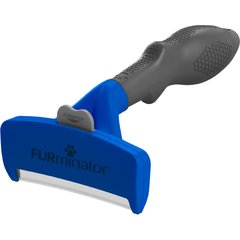Labrador Retriever vs. Golden Retriever: Which Friendly Breed Is Right for You?

Photo by Nevena1987/E+ via Getty Images
Looking for your new best friend? Labrador Retrievers and Golden Retrievers consistently top the charts as two of the most popular dog breeds in the U.S., and it’s easy to see why. With irresistibly sweet faces and tails that never stop wagging, both breeds make excellent companions.
So, Labrador Retriever versus Golden Retriever—how do you choose? We break down the similarities and differences below.
History
Plot twist! These lookalike pups are actually different breeds with origins on different continents.
Labrador Retrievers’ roots date to Newfoundland, where they descended from the now-extinct St. John’s Water Dog, according to The Labrador Retriever Club. They earned their reputation as skilled water dogs in the 1800s, thanks to their talent for helping fishermen retrieve their daily catches. Their waterproof coat, thick, otter-esque tail, and friendly demeanor made Labradors the ultimate fishing buddies.
English nobles visiting Canada were so impressed by these savvy swimmers that they brought them back to their country. Through selective breeding, they created the Labrador we know and love today.
Golden Retrievers, on the other hand, have Scottish origins. In the 1860s, a Scottish businessman named Dudley Marjoribanks, aka Lord Tweedmouth, developed an interest in breeding dogs.
With the goal of creating a hunting dog who excelled at retrieving game on land and in water, Marjoribanks mixed various breeds. This included an Irish Setter, a sandy-colored Bloodhound, the now-extinct Tweed Water Spaniel, and an unregistered yellow retriever, according to the Golden Retriever Club of America.
The result was the Golden Retriever, a friendly and intelligent dog with a soft mouth for retrieving delicate items—from waterfowl to your favorite shoes—without damage.
Appearance

Ever mistake a Golden Retriever for a Lab (or vice versa)? You’re not alone. These breeds share many similarities but have a few distinct differences.
Build
While they weigh close to the same amount (Labs are typically 55–80 pounds, while Goldens usually weigh 55–75 pounds), Labradors often look more substantial. “Labs tend to be heavier-appearing, or denser, dogs,” says Sandra Mitchell, DVM, DABVP, a veterinarian in Bangor, Maine.
Head Shape
Dr. Mitchell says Labs have a “blockier” head shape than Golden Retrievers, whose head typically has a more rounded appearance. Basically, think square versus circle.
Coat Type
The easiest way to spot the difference between a Labrador Retriever and a Golden Retriever is fur length. Labs have a dense, shorter coat that helps with water resistance. Meanwhile, those effortlessly beachy waves belong to Goldens.
A Golden Retriever’s coat is “longer and often soft and wavy, with long bloomers,” says Elizabeth Stelow, DVM, DACVB, chief of the behavior service at UC Davis in California. (“Bloomers” is a term for the fluffy fur on a dog’s rear end.)
Coat Color
Both breeds can have a yellow or blond coat, but Labs come in even more colors, including black, chocolate, white, silver, and red. Golden Retrievers stay true to their name and have a golden coat that ranges “from almost white to a deep auburn,” explains Dr. Stelow.
Personality
Labs and Goldens are both extroverts by nature. They’re friendly, smart, and full of joy, but they may express it differently.
“Labs tend to be ‘all-in’ and are a bit more over-the-top than Goldens, who tend to be more thoughtful about a situation,” says Dr. Mitchell. “Labs want to be the center of the party; Goldens just want to be included in the party.”
Key personality similarities and differences in the breeds include:
- Temperament: While both breeds are equally affectionate, social, and eager to please, Labs can be more exuberant. Goldens are often gentler and more patient.
- Attachment: Goldens generally form deep attachments to their pet parents and may even be a little “clingy,” says Dr. Mitchell. Goldens are also more prone to separation anxiety. Labs, though loving and affectionate, can be a bit more independent.
- Playfulness: Labs are known for their goofy, always-ready-to-play nature, typically acting like puppies into adulthood. Goldens also love to play but may be somewhat less boisterous.
Overall, no dogs comes with a personality guarantee. Just like people, each has their own personality shaped by nature and nurture.
Exercise Needs

Photo by Bogdan Malizkiy/iStock / Getty Images via Getty Images
As active dogs, Labs and Goldens thrive with daily exercise and attention. “Both breeds like exercise like Frisbee and running, but the dense coat of the Lab and their water background makes them excel at swimming as one of their regular activities,” says Dr. Mitchell.
Both Golden Retrievers and Labrador Retrievers need lots of daily exercise, but Labs tend to be more hyper and may require more activity than Goldens. Each breed needs at least 90 minutes of daily exercise, spread out throughout the day.
Both dogs need mental stimulation and jobs to focus on, such as learning tricks or retrieving items. If Goldens or Labs are allowed to grow bored, they can develop destructive behaviors like digging or chewing furniture.
Grooming
Golden Retrievers need their longer coat brushed regularly. They are “prone to mats, especially around the ears,” Dr. Mitchell says. Expect to groom a Golden every few days, at minimum, to reduce shedding and matting. A FURminator brush for long hair is best.
Labs might have shorter hair, but they’ll still have your vacuum working overtime. This is due to their dense undercoat, which Dr. Mitchell says sheds “all the time.” Brush Labs at least once per week and more frequently in the spring and fall, when they shed even more. Another FURminator brush, for short hair, does the trick.
As for mani-pedis, both dogs need regular nail trimming. You’ll also need to clean their ears regularly to prevent infections. Dr. Mitchell says this is especially important for Labs who like to swim and play in water.
Recommended Products
Health
“Medically, they are pretty similar,” says Dr. Mitchell. As big and active dogs, Golden Retrievers and Labs can both experience health issues such as:
- Elbow dysplasia
- Hip dysplasia
- Cancer, including hemangiosarcoma
- Eye conditions
While both breeds are generally healthy, preventive care, like weight management and vaccinations, is vital. Dr. Mitchell recommends working with your vet to get a plan tailored to your dog.
Labrador Retriever vs. Golden Retriever: Which Is the Breed for You?
There’s a lot to love about Labradors and Goldens, and if you ask us, you really can’t go wrong. But if you still can’t decide, here’s a cheat sheet:
A Lab might be right for you if:
- You have an active household that’s always doing something fun, such as swimming, hiking, playing, or throwing tennis balls.
- You don’t mind a high-energy dog who needs consistent training and stimulation.
- You’re OK with regular shedding and vacuuming up lots of fur.
A Golden might be better if:
- You love daily walks, games of fetch, and copious belly scratches.
- You want an instant best friend who will keep you active and social.
- You don’t mind regular grooming sessions.
The most important thing? “Treat each dog as an individual,” says Dr. Stelow. With proper training, care, and love, Golden and Labrador Retrievers can make a beloved addition to any household.
This content was medically reviewed by Teresa Manucy, DVM, Chewy veterinarian.







